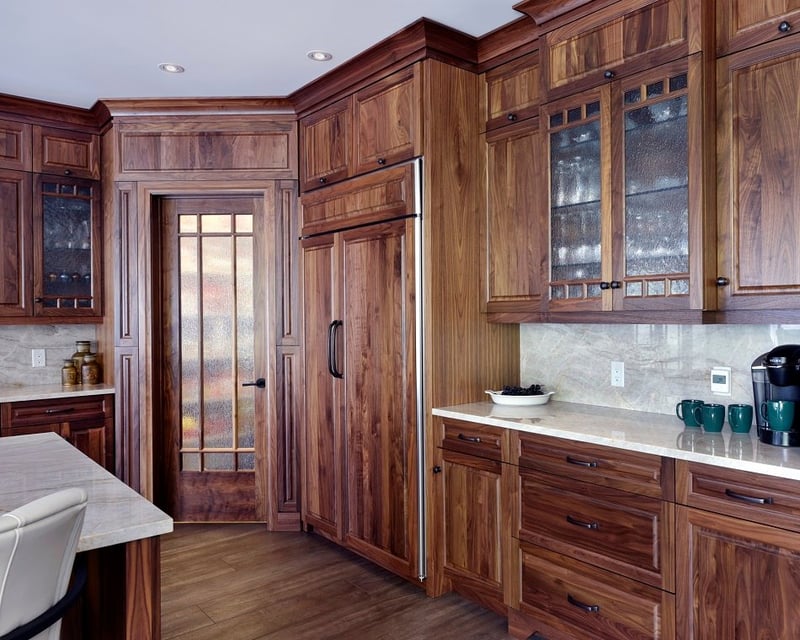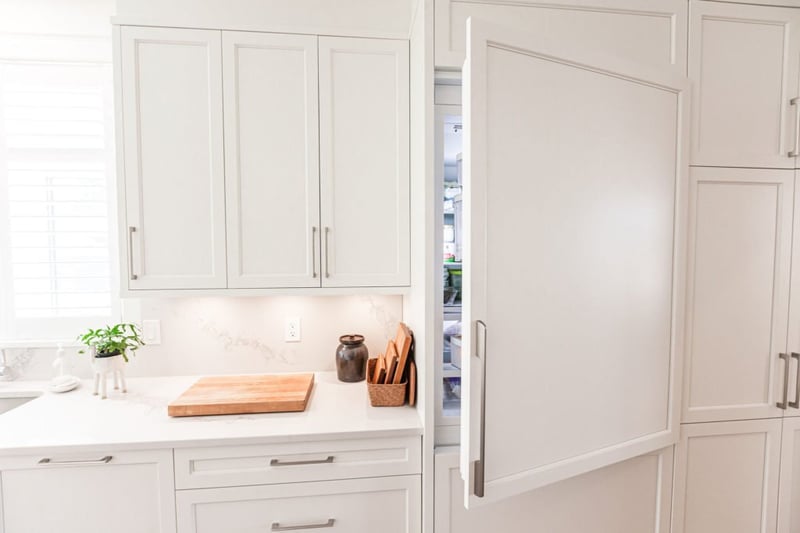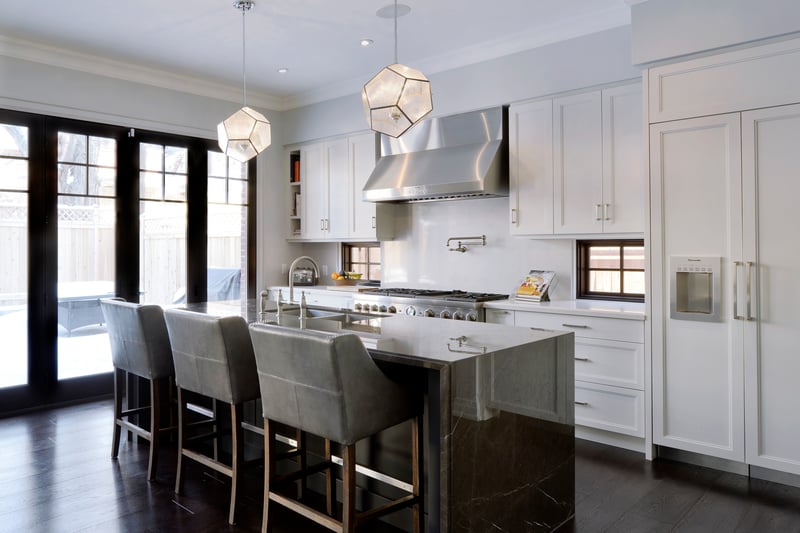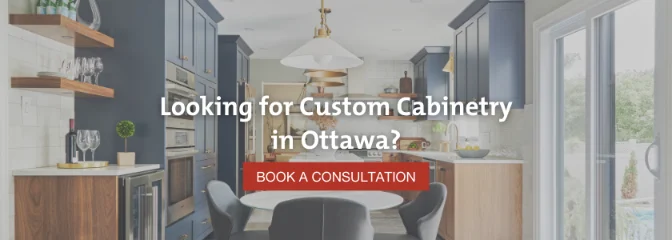22/03/2023 • Blog, Comparisons
Built-In Appliances vs. Countertop Depth: What's Right For You?
Estimated Read Time: 6 Minutes
A lot of homeowners are more focused on the appliances themselves rather than on how they’ll fit within their kitchen design. For good reason, as high-end, state-of-the-art appliances are vital to your kitchen’s overall functionality.
Moreover, In modern-day kitchens, two styles of appliances reign supreme: built-in and countertop depth.
At Deslaurier, we have over 40 years of experience manufacturing custom cabinets. While we do not supply kitchen appliances, we can manufacture custom overlay panelling for our clients’ built-in appliances.
With that, let’s take a side-by-side look at the differences between built-in and countertop-depth kitchen appliances.
|
Table of Contents |
What is a Built-in Appliance?
Right off the bat, let’s define some key terms.
If you’re planning a kitchen renovation, you’ve probably heard the term “built-in appliances” thrown around a lot. But what is a built-in appliance?
Technically speaking, built-in refers to all appliances that are set within a cabinetry system.
Sometimes, though, designers and other professionals in the industry use the word “built-in” as a generic definition for panelled appliances.
Panelled appliances are, as the name suggests, appliances covered up by a custom cabinet panel. All panelled appliances are built-in, but not all built-in appliances are panelled.
In a kitchen design, fridges and dishwashers are typically the most common appliances to the panel. However, other items in your kitchen can also be panelled as long as the device can accommodate them.
There are two primary types of panelled appliances: Overlay and Integrated. Let’s look at each one.
Overlay Appliances
An overlay panelled appliance has a custom-made cabinet door front designed to match the rest of your kitchen cabinetry.
The key thing to know about overlay appliances is that their ventilation systems remain exposed. As a result, the appliance may protrude slightly from the cabinets with parts of the chrome material remaining visible.

As you can see in this kitchen, even though the front overlay on the fridge matches the rest of the cabinetry, the visible metal strip around the edges indicates that it is, in fact, a fridge.
Integrated Appliances
Integrated appliances also use a matching custom panel, just like overlay appliances do, but the appliance is installed so that it’s completely flush and hidden within the cabinetry design.
The ventilation system works differently so the appliance is disguised to match perfectly with the rest of the kitchen cabinets.

Here, you can see an integrated fridge that blends seamlessly with the rest of the surrounding cabinets.
Choosing between overlay and fully integrated basically comes down to what aesthetic you want. If you don’t want to see your fridge at all, fully integrated is the way to go.
Buying Panel-Ready Appliances
It’s important to note that if you want an overlay or integrated appliance, you need to purchase appliances that have a “panel ready” designation. Panel-ready appliances are specifically manufactured to accommodate a custom panel.
Unless your current appliances are labelled as panel-ready products, you can’t use them in this type of application. You’ll have to buy new appliances for your kitchen renovation.
However, when you walk into your local appliance store, you may find that your options are quite limited. They may only offer a handful of panel-ready selections compared to the traditional kitchen appliances they have in stock.
What is a Countertop Depth Appliance?
“Counter-depth” is the distance from your kitchen wall or backsplash to the front of your kitchen countertop.
A countertop depth appliance is designed to be approximately 24-26 inches deep, which is similar to the depth of a standard kitchen countertop.
Technically, counter-depth does not account for the appliance doors, just the unit itself. Doors will end up extending the appliance unit roughly 3 or 4 inches past the countertop.
It still offers a much cleaner look than a traditional full-depth appliance. In the case of refrigerators, full-depth models could easily surpass 30 inches and protrude past the countertop.
With counter-depth appliances, you’ll just see the sides of the doors extended past the countertop.
Clearance
Built-in appliances do not need any clearance (or swing) space for opening doors. The thickness of the door will remain within the width of the fridge. This permits built-in refrigerator doors to be flush with cabinetry and side panels.
Typically, countertop depth appliances require several inches of clearance space. A lot of it is about the way manufacturers hinge the door. An average counter-depth stainless steel fridge door can swing in a manner that doesn’t require any additional space.
Most times, however, doors extend outside the width of the fridge, which necessitates extra room for clearance on the sides. While it equates to only a few inches of clearance, it is important to factor it into your kitchen’s overall design.
Cost
Comparing the cost between the two is fairly straightforward: built-in appliances will always be more expensive than countertop depth.
Countertop depth appliances are just regular appliances. As long as they are properly measured and accounted for in your kitchen’s design stage, they won’t come with any extra expenses.
Built-in appliances are an entirely different animal. A custom panel can cost over a thousand dollars, depending on the size of the appliance and materials used. If you’re outfitting all of your kitchen appliances with panelling, be prepared to spend thousands of dollars more than standard appliances.
Further, hardware for built-in overlay and integrated appliances is often overlooked as an expense, but it shouldn’t be. Appliance hardware can cost hundreds of dollars for just a single unit.
When planning your budget, it's crucial to think about the hardware aesthetic you want to achieve. This involves deciding whether to choose hardware that matches the appliance from the manufacturer or opt for hardware from a separate supplier that complements the rest of your cabinet hardware.
Not only that, built-in appliances are typically made by higher-end appliance brands, such as Miele. That means their basic cost – before custom panels and hardware – will be naturally more expensive than most appliance brands.
If you’re opting for a kitchen full of built-in appliances, prepare to spend hundreds, if not thousands more than you would for standard appliances.
Installation
Lastly, there is quite a large difference between installation methods of built-in and countertop depth appliances.
Counter-depth appliances are installed just like freestanding models.
Built-in refrigerators can be much trickier. As their doors open to the side of the unit rather than in front like a dishwasher or oven, different models will have different hinges, dimensions, and clearance requirements. All of these need to be taken into account during the design phase.
Overlay panels are different. At Deslaurier, while we do manufacture and supply custom overlay panels for appliances, we do not install them.
Installation of the custom panel onto a panel-ready appliance is handled by a professional installer who has experience working with these types of appliances. It's crucial to find a highly qualified professional to ensure that both the appliance and panel are installed correctly.
Other than refrigerators, other panel-ready appliances are fairly straightforward. All you need to know is the make and model of the appliance and its dimensions. Then, a custom panel can be manufactured and installed on the door.
One more note for panel-ready fridges is that they typically don’t have the same water or ice dispensers as standard models. While it might become more common with future advancements, it’s currently not customary to have a water dispenser with a seamlessly panelled appearance.

As shown, the dispenser feature on the door of the appliance cannot be covered by a panel alone. To accommodate this feature, a custom panel will need to be further customized with an opening for the dispenser, which will be mounted on the outside of the panel.
Instead, if you want a fully seamless panel-front fridge, the water and ice dispenser will need to be moved to the inside of the door.
While it’s not as practical as an outer dispenser, it is a small sacrifice for built-in refrigerators.
Design with Deslaurier Custom Cabinets
If you have your eye on custom cabinetry to pair with your new appliances, Deslaurier Custom Cabinets has everything you need!
Deslaurier’s extensive product catalogue offers 70+ unique door styles, with 80+ paints and stains to choose from. We also provide a sophisticated colour-match service to create distinctly unique cabinet paints for your custom kitchen.
Book a consultation for a one-on-one experience with a Deslaurier kitchen expert at our Ottawa showroom! With over 40 years of experience in our name, we provide our clients with a fully customized design process with our talented team of designers.
Live outside the area? Find a Deslaurier Dealer to connect with near you! Interested in becoming an authorized Deslaurier dealer? Visit our Become a Dealer page to learn more!
.png?width=224&height=80&name=Final%20(3).png)



